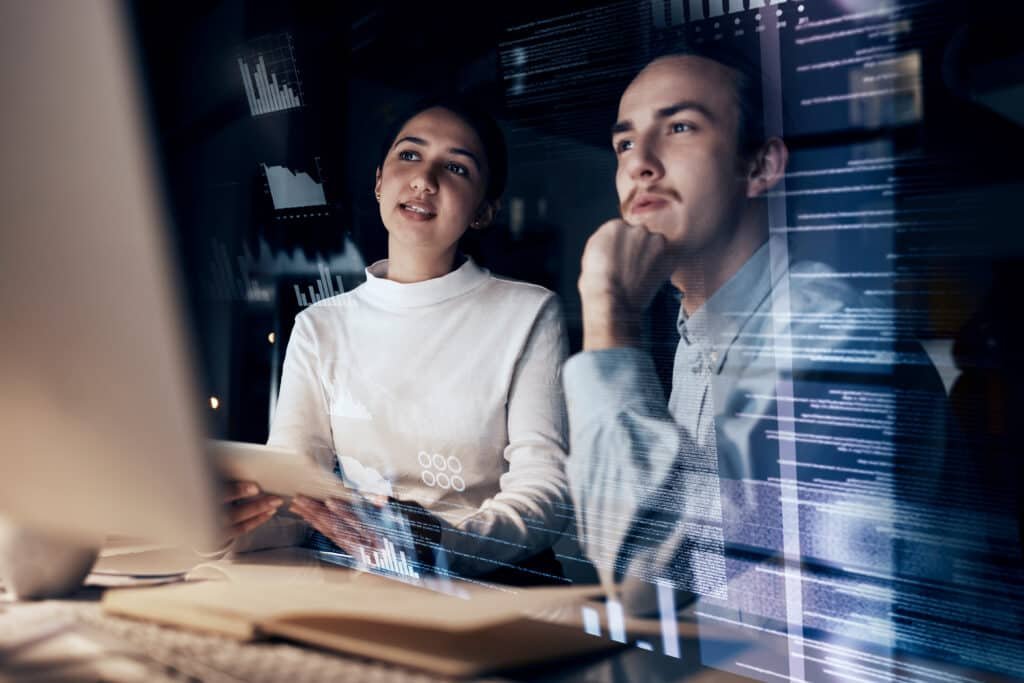What is Vishing? A Comprehensive Guide to Voice Phishing Prevention

We may earn a small fee from the companies mentioned in this post.
Imagine receiving an urgent phone call from a seemingly trustworthy source, only to later discover that you’ve fallen victim to a deceptive scheme. This is the harsh reality for countless individuals and businesses targeted by vishing attacks.
By understanding the tactics and techniques used by cybercriminals, we can develop strategies to defend against them. In this blog post, we’ll delve into the world of vishing, or voice call phishing attack, and explore “what is vishing” – how to recognise, prevent, and protect ourselves and our organisations from this growing threat.
Short Summary – What is vishing
Vishing is a malicious phone-based scam used to deceive victims into divulging sensitive information or transferring funds.
To protect against vishing scams, verify caller identities, safeguard personal information and report suspicious calls to the relevant authorities.
Businesses should provide employee training on vishing tactics, implement strong authentication protocols and monitor potential threats for protection.
Understanding vishing: voice phishing explained

Vishing is a form of fraudulent activity where perpetrators use phone calls to deceive victims into divulging confidential information or transferring funds, typically by impersonating legitimate organizations or authoritative figures.
The primary objectives of vishing attacks are to persuade victims to divulge personal or financial information, facilitating additional attacks and monetary or financial gain.
Vishing scams are very common, and one such example is the vishing scam where they either involve a prerecorded message or an individual calling unsuspecting victims and making them believe that their bank account, recent payments, or credit card has some sort of issue. They then take advantage of this by asking for account details, PINs, or other login credentials.
Scammers often acquire victims’ phone numbers from information exposed in data breaches or through phishing attacks. These criminals exploit the element of surprise in making calls, prompting their victims to take immediate action without considering the consequences.
By taking the necessary precautions, we can terminate criminal activities that may occur after a person divulges their confidential private information, such as account takeovers, credit card fraud, and identity theft.
You may find our easy to read article on how to spot phishing emails useful
Common vishing techniques

Malicious actors commonly employ techniques such as caller ID spoofing, social engineering, and automated messages to deceive victims and gain their trust in vishing scams, often with the goal of obtaining financial information.
To defend against these techniques, it’s essential to understand how they work and to take measures to prevent vishing attacks. Educating yourself and your team on the risks of vishing is the first step in protecting yourself.
Caller ID Spoofing
Caller ID spoofing involves disguising one’s identity by using a false phone number to appear as a legitimate caller or organisation. In vishing attacks, caller ID spoofing is employed to mask the identity of the caller, rendering it difficult to identify the real origin of the vishing call.
To protect ourselves from caller ID spoofing, follow these recommendations:
Remain vigilant and verify the caller’s identity before providing any personal information
Implement robust authentication protocols
Provide employee training to mitigate the risks of vishing scams.
Social Engineering
Social engineering is the utilisation of psychological tactics to exploit human behaviour in order to gain access to confidential information.
In fraud schemes, perpetrators employ various social engineering techniques, such as requesting a person’s bank account, information, credit card details, and a mailing address, or prompting the victim to take action by transferring funds, emailing confidential work-related documents, or providing information regarding their employer.
Examples of social engineering tactics in vishing attacks include fear or panic-based vishing, excitement or desire-based vishing, and tech support fraud. By being aware of these tactics, we can better protect ourselves from falling victim to vishing scams.
Automated Messages
Automated messages refer to pre-written messages that are scheduled and sent automatically to recipients, either as text messages or recorded voice messages. In fraud scams, automated messages are utilised to direct victims to call a spoofed number or provide personal information.
These messages facilitate the efficient utilisation of time and resources by enabling businesses to transmit personalised messages expeditiously and economically.
Checkout our informative arcticle on essential cyber security awareness training
Recognising vishing scams

Vishing scams are known to utilise urgent requests, forceful language, and unsolicited offers. In order to identify vishing scams, it is important to be aware of these common tactics and to verify the legitimacy of the caller.
For instance, vishing scammers may attempt to deceive individuals by posing as reputable organisations or authority figures, including Microsoft tech support, Amazon, or local hospitals. By familiarising ourselves with these tactics, we can more effectively recognise and avoid vishing scams.
The impact of vishing attacks

Vishing attacks can result in identity theft, account takeovers, and financial loss for individuals. For businesses, the consequences can be even more severe, leading to financial loss, data compromise, and harm to the reputation of the organisation.
As such, it is crucial for both individuals and businesses to be proactive in defending against vishing attacks and minimising their impact.
Protecting yourself from vishing scams

To protect ourselves from vishing scams, we must focus on three main strategies: verifying caller identities, safeguarding personal information, and reporting suspicious calls to the appropriate authorities.
Let’s dive deeper into each of these approaches.
Verifying Caller Identities
Confirming caller identities can be accomplished by:
Conducting an independent investigation of the organisation or individual
Getting in touch with them through a validated phone number
Requesting the caller’s name, company name, and contact information to help verify their identity.
It is essential to remain cautious when answering calls from unknown numbers and to adhere to established security protocols to avoid falling prey to voice phishing attacks.
Safeguarding Personal Information
Preserving personal information necessitates exercising caution when divulging confidential information over the phone and being cognisant of typical vishing strategies. To protect our personal information, we should refrain from disclosing personal details such as credit card numbers, bank account details, or our social security number over the phone, especially when dealing with credit card companies.
By being cautious when providing our phone number to unknown sources and registering our number with the National Do Not Call Registry, we can protect our privacy and reduce the risk of becoming a victim of a vishing scam.
Reporting Suspicious Calls
Reporting suspicious calls assists law enforcement in tracing and deterring future such vishing calls and assaults, in addition to raising awareness about the matter. Suspicion calls can be reported to:
Action Fraud at 0300 123 2040 or through their website
The Information Commissioners Oiffice (ICO) for nuisance calls and spam texts
Some phone providers provide the facility to report suspicious text messages by forwarding them to 7726.
By reporting suspicious calls, we can contribute to the fight against vishing attacks and help protect others from falling victim to these scams.
Vishing prevention for businesses
Businesses also need to take proactive measures to prevent vishing attacks. By providing employee training, implementing robust authentication protocols, and vigilantly monitoring for potential threats, businesses can minimise the risk of vishing attacks and protect their valuable data and reputation.
Employee Training

Employee training should emphasise increasing comprehension of vishing assaults and the methods employed by cybercriminals, such as caller ID spoofing, social engineering, and automated messages. It is crucial for employees to be aware of the tactics used in vishing attacks and to understand how to identify at-risk employees.
By providing continuous security awareness training and keeping employees informed and vigilant, businesses can reduce the risk of falling victim to vishing attacks.
Checkout our informative blog on – what a cyber attack means
Strong authentication measures

Implementing strong authentication measures, such as multi-factor authentication, can help protect businesses from vishing attacks by adding an extra layer of security. Examples of strong authentication measures include:
Multi-factor authentication
Certificate-based authentication
Biometric authentication
Token-based authentication
These measures can act as a deterrent against unauthorised access to a victims personal information, and increase the overall security of systems and networks.
You may find our article on two-factor security useful
Monitoring for potential threats

Staying informed of emerging trends and tactics is paramount in protecting businesses from potential threats. To remain knowledgeable of current vishing tactics and trends, it is recommended to:
Consistently observe news sources, industry publications, and security blogs
Regularly conduct audits of systems and processes
Inform all personnel of the most recent security protocols
By closely monitoring for potential threats and updating security protocols accordingly, businesses can minimise the risk of vishing attacks and safeguard their valuable assets.
Check out our informative blog on the 7 types of cyber security threats
Real-life vishing scenarios
Real-life vishing scenarios provide valuable insight into the tactics used by cybercriminals. For instance, during the COVID-19 pandemic, criminals contacted individuals offering vaccines and testing kits in exchange for their bank account information and mailing address.
The tax submission deadline also sees a rise in scams, with criminals leaving messages purporting to be from the government agency, Inland Revenue, claiming potential issues with a victim’s tax return and potential penalties under the law if no action is taken.
Another example is technical support fraud, where scammers masquerade as well-known companies and present pop-up notifications regarding the safety of the victim’s computer, offering additional false tech support numbers.
By understanding these real-life scenarios, we can gain a better understanding of the methods and tactics used by cybercriminals and be better prepared to protect ourselves and our businesses from vishing attacks.
Conclusion
In conclusion, vishing attacks pose a significant threat to both individuals and businesses, with severe consequences such as identity theft, account takeovers, and financial loss.
By understanding the tactics used by cybercriminals, recognising common vishing scams, and implementing protective measures, we can reduce the risk of falling victim to these attacks.
It’s crucial for all of us to remain vigilant, stay informed, and take action to safeguard our personal information and the security of our organisations.
Frequently Asked Questions
How can I protect myself from vishing attacks?
Verify caller identities, safeguard personal information, and report suspicious calls to the authorities to protect yourself from vishing attacks.
What is an example of vishing?
Vishing is a scam where fraudsters call the victim pretending to be from their bank, credit card company or another institution and ask them to call back on a given number. This automated message is often preceded by an SMS with a false alert.
What is the difference between phishing and vishing?
Phishing involves sending malicious emails to steal confidential data, while Vishing is a type of attack that uses voice communication over the phone or voicemail to obtain the same sensitive data. Smishing uses text messages for the same purpose.
What are common vishing techniques?
Vishing techniques commonly used by cyber criminals include caller ID spoofing, social engineering and automated messages.
What measures can businesses take to prevent vishing attacks?
Businesses can prevent vishing attacks by providing employee training, implementing strong authentication protocols, and monitoring for potential threats.
Useful reference sites
- Action Fraud – actionfraud.police.uk
- The UK’s national reporting centre for fraud and cybercrime, offering information on various scams, including vishing.
- Which? Consumer Rights – which.co.uk
- A consumer rights organization that provides advice and information on various scams, including vishing.
- Financial Conduct Authority (FCA) – fca.org.uk
- The FCA offers guidance on financial scams, including vishing, and how consumers can protect themselves.
- Citizens Advice – citizensadvice.org.uk
- Offers free, confidential advice on various topics, including how to recognise and report vishing scams.
With over three decades of experience in the heart of London’s financial sector, I have dedicated my career to the pursuit of robust cybersecurity practices and IT leadership. As a Certified Information Systems Security Professional (CISSP), Certified Information Security Manager (CISM), Certified Chief Information Security Officer (C|CISO), Certified Ethical Hacker (CEH), and Computer Hacking Forensic Investigator (CHFI), I bring a wealth of knowledge and expertise to the table.
My journey in the field of cybersecurity has not only been about personal growth but also about sharing my insights with others. As an international speaker, I have had the privilege of addressing audiences worldwide, discussing the importance of cybersecurity in today’s digital age. My passion for knowledge sharing extends to my work as an author and blogger, where I delve into the complexities of cybersecurity, offering practical advice and thought leadership.
In my role as a CISO and Head of IT, I have overseen the development and implementation of comprehensive information security and IT strategies. My focus has always been on creating resilient systems capable of withstanding the evolving landscape of cyber threats.
My Master’s degree in Cybersecurity has provided a solid academic foundation, which, when combined with my practical experience, allows me to approach cybersecurity from a holistic perspective.
I am always open to connecting with other professionals in the field, sharing knowledge, and exploring new opportunities. Let’s secure the digital world together.

